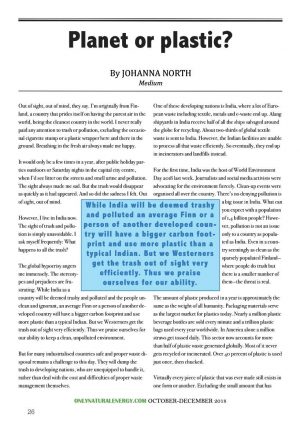 Out of sight, out of mind, they say. I’m originally from Finland, a country that prides itself on having the purest air in the world, being the cleanest country in the world. I never really paid any attention to trash or pollution, excluding the occasional cigarette stump or a plastic wrapper here and there in the ground. Breathing in the fresh air always made me happy.
Out of sight, out of mind, they say. I’m originally from Finland, a country that prides itself on having the purest air in the world, being the cleanest country in the world. I never really paid any attention to trash or pollution, excluding the occasional cigarette stump or a plastic wrapper here and there in the ground. Breathing in the fresh air always made me happy.
It would only be a few times in a year, after public holiday parties outdoors or Saturday nights in the capital city centre, when I’d see litter on the streets and smell urine and pollution. The sight always made me sad. But the trash would disappear as quickly as it had appeared. And so did the sadness I felt. Out of sight, out of mind.
However, I live in India now. The sight of trash and pollution is simply unavoidable. I ask myself frequently: What happens to all the trash?
The global hypocrisy angers me immensely. The stereotypes and prejudices are frustrating. While India as a country will be deemed trashy and polluted and the people unclean and ignorant, an average Finn or a person of another developed country will have a bigger carbon footprint and use more plastic than a typical Indian. But we Westerners get the trash out of sight very efficiently. Thus we praise ourselves for our ability to keep a clean, unpolluted environment.
But for many industrialised countries safe and proper waste disposal remains a challenge to this day. They will dump the trash to developing nations, who are unequipped to handle it, rather than deal with the cost and difficulties of proper waste management themselves.
One of these developing nations is India, where a lot of European waste including textile, metals and e-waste end up. Alang shipyards in India receive half of all the ships salvaged around the globe for recycling. About two-thirds of global textile waste is sent to India. However, the Indian facilities are unable to process all that waste efficiently. So eventually, they end up in incinerators and landfills instead.
For the first time, India was the host of World Environment Day 2018 last week. Journalists and social media activists were advocating for the environment fiercely. Clean-up events were organised all over the country. There’s no denying pollution is a big issue in India. What can you expect with a population of 1,4 billion people? However, pollution is not an issue only to a country as populated as India. Even in a country seemingly as clean as the sparsely populated Finland — where people do trash but there is a smaller number of them — the threat is real.
The amount of plastic produced in a year is approximately the same as the weight of all humanity. Packaging materials serve as the largest market for plastics today. Nearly a million plastic beverage bottles are sold every minute and a trillion plastic bags used every year worldwide. In America alone a million straws get tossed daily. This sector now accounts for more than half of plastic waste generated globally. Most of it never gets recycled or incinerated. Over 40 percent of plastic is used just once, then chucked.
Virtually every piece of plastic that was ever made still exists in one form or another. Excluding the small amount that has been burned, consequently harming the environment nevertheless. As of 2015, more than 6,9 billion tons of plastic waste had been generated. About 9 percent of that was recycled, 12 percent incinerated, and 79 percent accumulated in landfills or environment. Globally, 73 percent of beach litter is plastic. Rough calculations for how long plastics endure vary from 450 years to forever.
In the Mediterranean, the enormous amount of plastic trash combined with improper waste management results in over 95 percent of the waste that ends up in the oceans being plastic. Bags, bottle caps, synthetic fibres from clothing, tiny rice-sized bits. Plastic breaks down, but it can’t biodegrade. It breaks down into small microplastics and even nanoplastics, which then spread all over the marine ecosystem and eventually end up back to the dry land through food cycle. The microplastics, at a record high in the Mediterranean, are a particular concern to the scientists. The concentration is a whopping four times higher than that of the infamous Great Pacific Garbage Patch! Only one percent of the world’s water is in the Mediterranean, but it contains as much as 7 percent of all the microplastics.
Recently, scientists at the University of Eastern Finland released a survey where they studied the microplastic concentration in Finnish lakes. It hasn’t been until the past few years that the researchers have realised the issue in freshwater bodies too. Relatively, there might even be more plastic in the lakes than in the oceans.
Plankton, the tiny organisms that live near the ocean surface and drift along freshwater bodies, play a vital role in the stability of the marine ecosystem. Plankton are the key to the climate and food cycle. They are the basis of all existence of life on earth.
A few years ago, scientists discovered that some species of zooplankton (animal plankton) are eating plastic. Microplastics resemble their food and thus become appealing to the hungry crustaceans. The ingestion of plastics introduces toxic chemicals into the food chain already at a very preliminary level affecting the entire marine ecosystem.
Scientists also agree that there is oxygen from ocean plants in every breath we take. Most of this is from phytoplankton via photosynthesis. It’s difficult to make a precise calculation of the total number, but a popular estimation is that phytoplankton contribute between 50 and 85 percent of the oxygen in earth’s atmosphere, which nonetheless is most of the air we breathe.
18 billion pounds of plastic end up in the ocean each year. There are over five trillion pieces of plastic in our oceans. Ocean plastic is estimated to kill millions of marine animals every year. Nearly 700 species, including endangered ones, are affected by it — some visibly, many more probably invisibly.
Plastic trash is found in 90% of seabirds. One million seabirds and around a 100,000 marine mammals are killed annually from plastic in our oceans. And the rates keep growing as the production of plastics increases. By 2050 every seabird species on the planet will be eating plastic. Marine species of all sizes, from zooplankton to whales, now eat microplastics — as do we people.
Imagine your home. There you have a big, secret closet. You don’t have the time or energy to clean your house properly or to find out about the proper methods for waste disposal. Nor have you thought about these issues beforehand in your consumer decisions. But you do not want to live in the middle of a chaotic wasteland. So what do you do?
You keep just tossing everything in the secret closet, where it will accumulate day by day, but hidden from your eyes and thoughts. Out of sight, out of mind. You can pat yourself on the back. You are a tidy, well-organised human being. At least until the closet can’t take in any more waste and you’ll be in the middle of a much bigger disaster than you would have originally had to deal with.
Johanna North
Originally published
by Medium.com
June 13, 2018





